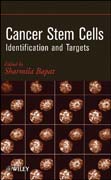
Because the concept and discoveries of cancer stem cells are relatively new, scientists and researchers need an introduction to this dynamic area. Cancer Stem Cells presents a consolidated account of the research done to date and recent progresses in the studies of cancer stem cells. Such a presentation facilitates a better understanding of and draws attention to stem cell and cancer biology two fields that enhance, move, and evolve into each other continuously. It provides an informative study in designing approaches to apply stem cell principles to cancer biology while offering an overview of the challenges in developing combination stem and cancer biology targets for therapeutics. This book serves as a primer for new researchers in the field of cancer biology. INDICE: 1. Cancer Stem Cells (CSCs): Similarities and Variation of the Theme of Normal Stem Cells (Sharmila Bapat, Anne Collins, Michael Dean, Kenneth Nephew, and Suraiya Rasheed). 1.1 Introduction. 1.2 Stem cells in the life of an organism. 1.3 Cancer Stem Cells (CSCs). 1.4 Self-renewal and differentiationin CSCs. 1.5 CSC plasticity as regulated by intrinsic and extrinsic factors. 1.6 Future Perspectives. 1.7 Abbreviations. 1.8 References 2. Leukemic Stem Cells (Sharmila Bapat). 2.1 Introduction. 2.2 Dysregulation of hematopoiesis in leukemia. 2.3 Identification and isolation of Cancer Initiating Cell(s) in Leukemia. 2.4 Molecular regulation of the aberrant hierarchies. 2.5 Future Perspectives. 2.6 Abbreviations. 2.7 References 3. Isolation and Characterization ofBreast and Brain Cancer Stem Cells (Meera Saxena, and Annapoorni Rangarajan).3.1 Introduction. 3.2 Breast cancer Stem Cells. 3.3 Brain Cancer Stem Cells. 3.4 Conclusion. 3.5 Abbreviations. 3.6 References. 4. Cancer Stem Cell Side Populations (Danuta Balicki, and Raymond Beaulieu). 4.1 Introduction. 4.2 Stem cell side populations (SP). 4.3 SP in normal tissues. 4.4 SP in tumors. 4.5 Overcoming SP limitations. 4.6 Conclusion and future perspectives. 4.7 Abbreviations. 4.8 References. 5. Evidence for Cancer Stem Cells in Retinoblastoma (GailM. Seigel). 5.1 Introduction. 5.2 Elusive Origins of Retinoblastoma. 5.3 Sources of Retinoblastoma cells for study. 5.4 Precedent for cancer stem cells. 5.5 Side populations in Retinoblastoma. 5.6 Immunoreactivity to stem cell markers in Retinoblastoma. 5.7 Conclusion. 5.8 Abbreviations. 5.9 References. 6. Ovarian Stem Cell Biology and the Emergence of Ovarian Cancer Stem Cells (Anjali Kusumbe, and Sharmila Bapat). 6.1 Introduction. 6.2 Human ovary: An overview. 6.3 Stem/Progenitor Cells Exist In the Adult Mammalian Ovary. 6.4 Is ovarian cancer a stem cell disease? 6.5 Abbreviations. 6.6 References 7. Prostate Cancer Stem Cells (Stefanie Hager, Norman Maitland, and Anne Collins). 7.1 Introduction. 7.2 The human prostate: biology, gland architecture and pathological alterations. 7.3 Prostate epithelial stem cells. 7.4 Prostate cancer stem cells. 7.5 Stem cell tracking in the prostate. 7.6 Conclusions and future directions.7.7 Abbreviations. 7.8 References. 8. Molecular Signatures of Highly Malignant Melanoma Stem Cells (Suraiya Rasheed). 8.1 General Properties of Human Melanomas. 8.2 Characteristics of Stem Cell-derived Melanomas. 8.3 The Cat Model System for Stem Cell Melanomas. 8.4 Challenges of Research in Cancer Stem Cells and Therapeutics. 8.5 Summary and Conclusions. 8.6 Abbreviations. 8.7 References. 9. Invasion Program of Normal and Cancer Stem Cells (David Olmeda, Gema Moreno-Bueno, David Sarrió, José Palacios, and Amparo Cano). 9.1 Introduction. 9.2 The basics of tumor progression: invasion and metastasis. 9.3 Epithelial tomesenchymal transitions in development and its relation to the invasive process. 9.4 Regulation of EMT: from signals to molecular pathways. 9.5 EMT and cancer stem cells. 9.6 Can stem cell properties be extensive to invasive tumor cells?. 9.7 Is there a unique EMT program linked to invasion? 9.8 Evidences of EMT in human clinical tumors. 9.9 Expression of mesenchymal markers and cadherin switching in carcinomas. 9.10 Expression of EMT inducers in human tumors. 9.11 EMT may occur in a specific subset of breast carcinomas. 9.12 Conclusions and perspectives. 9.13 Abbreviations. 9.14 References. 10. Epigenetics in Cancer Stem Cell Development (Kenneth Nephew, Curt Balch, Tim H.M-Huang, Zhang Shu,Michael Chan, and Pearlly Yan). 10.1 Introduction. 10.2 Characterization of candidate cancer stem cells. 10.3 Possible origins of cancer stem cells. 10.4 Epigenetics in normal development. 10.5 Epigenetic regulation of the cancer stem cell phenotype. 10.6 Contributions of epigenetics to drug resistance in cancer stem cells. 10.7 Genome-wide interrogation of epigenetic modifications in cancer stem cells. 10.8 Epigenetic therapies against poorly differentiated cancer cells. 10.9 Summary and Future Directions. 10.10 References. 11. Cancer Stem Cells and New Therapeutic Approaches (Michael Dean). 11.1 Cancer Stem Cells.11.2 Activation of stem cells and Cancer. 11.3 Major Cancers and Risk Factors. 11.4 Treatment implications. 11.5 Future Research. 11.6 Conclusions. 11.7 References. 12. Immunobiology of Cancer Stem Cells (Shubhada Chiplunkar). 12.1 Cancer Stem Cells. 12.2 Cancer Stem Cells and lymphocytes. 12.3 Trafficking of normal and metastasis of cancer stem cells. 12.4 References.
- ISBN: 978-0-470-12201-3
- Editorial: John Wiley & Sons
- Encuadernacion: Cartoné
- Páginas: 276
- Fecha Publicación: 07/11/2008
- Nº Volúmenes: 1
- Idioma: Inglés
